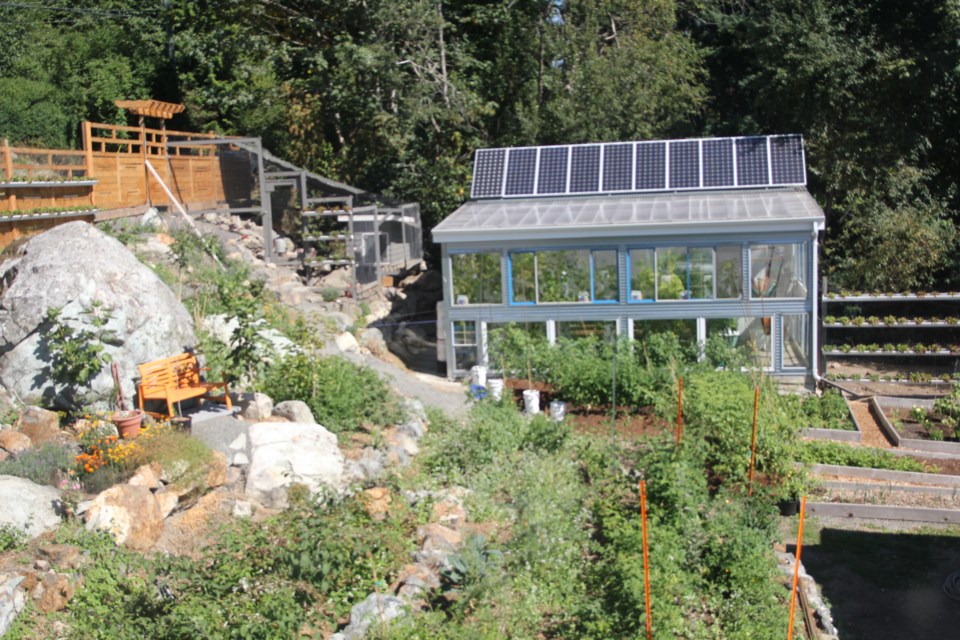When Wayne Tatlow purchased his acre and a quarter of land a little less than three years ago, there was nothing on the property but blackberries and a small driveway. Coming from Canmore, Alberta, he had big dreams for the place.
“I wanted to not be working for a utility company,” says Tatlow. “When I left Canmore, you were not allowed to put up solar and I really wanted to be self-sufficient in energy, and also as much as possible in food. So that’s what I was aiming for when I started building this place.”
Tatlow says he feel that he’s close to achieving both of these goals, but the building of his home on the land he calls Black Cat Farm is a work in progress. His land now has 3500 square feet of buildings, all of which are connected to a solar and a wind energy system. He is living, currently, in what he calls the guest house, a two-bedroom, 765 square-foot building heated by a small woodstove and sunlight streaming through massive windows facing east.
“The way the windows are designed and placed, I can strategically control the temperature in the house,” says Tatlow.
A 416 square-foot greenhouse is visible from the north-facing windows of the guest house. Constructed with the windows from a locally torn-down house, Tatlow says the building holds heat because of its double-walled roof that lets in 90 percent of sunlight, and sandy floor.
“In January, it can get as warm as 27 degrees celsius in there, the sand acts as a heat sink. At night it goes down to about 11 degrees,” says Tatlow.
Right now Tatlow has tomatoes, squash, basil, and cucumber growing in the greenhouse. The plants grow vertically out of towers with water in their base that gets pumped up to the top and drips down through the growing pods every 45 minutes, for 15 minutes. Known as Aeroponic gardening, Tatlow says this method consumes just 10 percent of the water required for gardening in beds of soil, is pest-free, and because of nutrient additives, faster-growing.
When the cold weather hits, Tatlow says he’ll bring in other plants including the lemon and lime trees that are currently outside.
The building he calls the solar shed holds all the equipment to run the 28 solar panels and feed the electricity they create back into the grid. There’s an inverter that monitors the panels and delivers information including how long they’ve been creating power on that particular day (on the day of the Undercurrent visit, they started harvesting the sun’s energy at about 5 a.m.) and how much energy they’ve created.
The solar panels at Black Cat Farm not only power the buildings’ lights, but power the energy sucking tools (a welder, for example, which runs on 220 volts) in Tatlow’s workshop.
Tatlow says that if he has one regret about his work on Black Cat Farm since acquiring the land in 2011, it’s that he didn’t build a larger solar power system to begin with.
“People told me it wouldn’t work, because there isn’t enough sunlight here,” says Tatlow. “But my experience so far proves this incorrect. Even in winter, on cloudy, overcast days, there is enough sunlight for these panels to make energy.”
Tatlow says that every two months he gets a $20 bill from BC Hydro, and he is looking forward to a cheque from BC Hydro at the end of the year as payment for the energy Black Cat Farm pumps back into the grid every day.
The fourth building on Tatlow’s property (not including the chicken coop) is the main house, a work in progress. When it is complete, the two-bedroom, 1,300 square foot home will be heated by pipes carrying hot water through the floor. That water will be heated, initially, by travelling through tubes on the roof that the sun’s rays. Any extra heating required will be added by an on-demand hot water heater.
Tatlow points to his windmill as an example of one of the aspects of his property that hasn’t worked out as well as he had hoped.
“I didn’t hire an engineer or do any kind of study to tell me where to place it, I just spent the $2,000 and installed it myself. Is it paying for itself? Maybe it will, eventually, but I figure you never know these things until you try them. I like the idea that I can share this knowledge, though, and maybe other people can carry on and build on that.”
Get a tour of Black Cat Farm yourself, as well as Endswell Farm and the Ruddy Kitchen garden at the Bowen in Transition Sustainability Tour this weekend. To register, contact Shasta Martinuk at [email protected] or call 604-947-9228.



